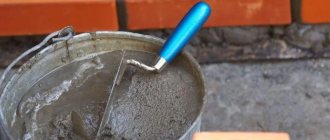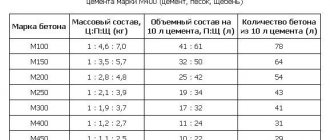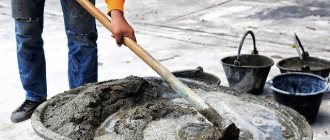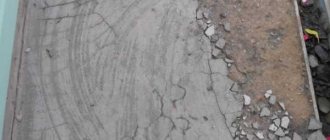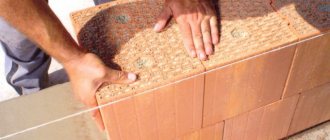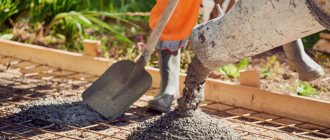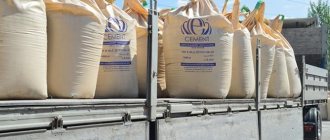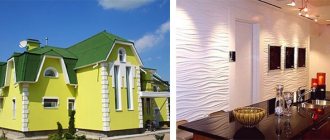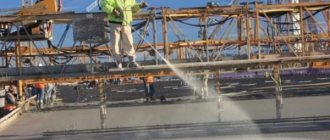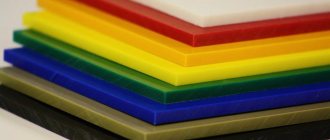Characteristics of concrete mortar
Cement is a narrower concept, since it is part of concrete and is one of its main components.
Recently, the concept of cement mortar has been used quite often. It is a composition of sand, cement and a certain amount of water. In modern conditions, it is very often possible to add various types of plasticizers and other additives to such a mixture, which impart particularly high frost resistance, water resistance, and also increase the strength of the mixture several times, which prevents cracking of the coating in the future. When making concrete, various additives are added to the mixture to improve its properties.
The main filler is sand. It is known that the sand fraction is quite small, so the use of such solutions for the main filling of surfaces is impractical. At the same time, it is very convenient for them to perform more painstaking and minor work, where large fractions of filler are strictly unacceptable.
Thus, with the help of cement mortar, it is best to fill the seams between slabs and other connecting elements in construction, plaster walls to seal them or give them a decorative appearance, and also treat the surface of concrete-filled patios and steps.
When making a concrete mixture, cement is a binder that ensures its hardening.
Concrete is a compound that, when liquid is added, turns into a fairly solid structure. In a concrete mixture, cement acts as a binder, which ensures better hardening and setting. Therefore, concrete mixture is considered to be a composite material. The big advantage is that it is used for the construction of large (including load-bearing) building structures, which explains the difference in the use of concrete and cement mortars.
Typically, the consistency of concrete includes sand, gravel (or granular slag) and cement.
To make a concrete mixture, you need to take clean sand.
Not just any cement can be used, but a special one. Portland cement, well known in the construction industry, is best suited. This is a fairly heavy and high-strength type of cement. It is usually marked from M350 to M500. Cement of lower grades (less than M350) is definitely not suitable for concrete mortar, but is perfect for cement mortar, which will subsequently be used for plastering work.
As for choosing the grade of sand for cement, there are no special requirements. The sand just needs to be fairly clean, river sand, and it shouldn’t contain clay impurities.
Often, gravel or slag of two fractions is used as the main filler in concrete mortar: large and fine. This is necessary to ensure greater reliability of the solution. It is best to choose granite gravel of several fractions as a filler. No other gravel (carbonate, gypsum, chalk and others) needs to be used, since over time it begins to crumble very much, and therefore is quite poorly fixed in the composition.
Types of construction cement
Scheme of ultimate strength of VBC and VRC
Waterproof Expanding is a fast-setting, fast-setting hydraulic binder. The production process is by mixing gypsum, highly basic calcium hydroaluminate and aluminous cement. It is used to restore damaged reinforced concrete and concrete structures and to create waterproof joints.
White is a material of finely ground clinker with gypsum.
Colored cements are obtained from white cements by adding coloring additives. But this reduces their strength.
These two types are used in the decoration of buildings.
Fast-hardening - it has a very high rate of increase in strength during hardening. It is used in masonry work.
Aluminous is obtained from limestone and alumina as a result of grinding. Since the process of its production includes a firing phase, it turns out that this material is very expensive. It is used for transport and military construction, as it is of higher quality.
Concretes and mortars containing aluminous ingredients have high water resistance and fast setting time.
Portland or Portland cement is a type of hydraulic binder consisting of calcium silicates. It is obtained by grinding clinker with gypsum so that the setting time can be adjusted. This material has high performance properties. It is used for the manufacture of prefabricated reinforced concrete and monolithic structures.
All types of cement have a grade indicating its strength: the higher the grade, the stronger the structure created on the basis of this material.
Proper preparation and production features
To obtain the highest quality composition in terms of characteristics and operational capabilities, all components should be mixed in compliance with their proportions. The result is especially influenced by what percentage of water the finished volume of cement mortar contains. Precision in the manufacture of any mortar is extremely necessary in order to maintain its high-level performance properties - strength indicators and the ability to withstand the influence of external factors.
The basic technological qualities that conventional cement has can be improved. The manufacturer for certain brands of the manufactured product can provide:
- water and frost resistance;
- make the consistency more fluid, which allows this homogeneous, evenly distributed mass to be poured into formwork or applied in layers when finishing various surfaces;
- ensure the plasticity and quality of the adhesive for tiling with tile materials (possibly through the use of resinous additives).
The universal difference between cement is that it can serve as the basis from which the desired building material is obtained, both similar to the original one and in a completely different form. In particular, builders often prepare the required volumes of concrete mixture from it, and at the plant they produce reinforced concrete, achieving high mechanical strength due to the reinforcement of a substance that quickly hardens.
Attention! The difference between concrete is that it is produced on a cement base, also adding sand and various structural elements that form the qualities of this product.
How and why is cement used?
Cement is used to prepare the mortar of the same name. To do this, it is diluted with water, and sand and various components are added to the composition to increase strength, resistance to moisture and other necessary qualities. The result is a “doughy” consistency. Once cured and cured, the mortar becomes hard and waterproof.
Cement mortars are used for laying building materials, filling joints between blocks and treating surfaces. For example, it is used for screeding floor coverings under linoleum, laminate and parquet. They can also be used to plaster walls.
Use of special additives
Mineral supplements
When choosing or producing cement mortar, it is necessary to pay special attention to the possibility of using special additives. Currently, experienced builders prefer to use special mineral additives most often. As the latter, they choose fly ash, silica, lime or fine granulated slag.
We suggest you find out which bed linen is better - calico, satin or poplin
The use of such additives is due to a significant improvement in properties. Typically, it is the grades of cement under the codes CEM III, CEM IV and CEM V that are characterized by an incredibly high presence of mineral additives. CEM I grade cement is identified as pure, and CEM II grade is distinguished by a small amount of additives (no more than 20%).
Advantages
The additives described above permanently extend the service life of products, making them resistant to corrosion and other negative factors affecting the external environment. And under their influence the mixture itself becomes much more plastic, easier to work with, and it sets faster and more reliably. It should also be taken into account that the use of mineral additives in concrete mixtures is now becoming quite common.
Plasticizers
As for special additives for concrete mixtures, special plasticizers are most often used in the manufacture of the highest quality grades. One of the best plasticizers today is the C-3 plasticizer. It significantly increases the adhesion of concrete to reinforcement, making it more plastic and at the same time resistant to the influence of adverse external factors. Therefore, even for the simplest concrete mortar, it is better to additionally add at least a small amount of such a plasticizer.
Reinforcing additives
A reinforcing additive is necessary for the strength of the concrete solution.
There are times when it is necessary to achieve maximum strength and stability of the concrete solution. This usually happens when laying foundations for buildings on poor soils, and also when manufacturing large and heavy metal-concrete structures. For these purposes, it is better to use special reinforcing additives.
It is the most reliable and convenient to use basalt fiber. This is explained by the fact that it is absolutely not susceptible to rotting and burning, and in addition it has extremely high strength. However, when purchasing this type of additive, you must carefully read the instructions and add the exact amount of fiber to the concrete solution, which is indicated on the manufacturer’s packaging.
Some differences in concrete mixtures in composition
Concrete composite consists of the following components:
- A binder that is most often used in the form of cement.
- Various types of sand.
- Crushed stone or gravel.
- Water.
- It is possible to introduce various additives.
View gallery
In this case, the cement is selected of a specific type. But in most cases they resort to the PC500 brand. It is perfect for various designs. To find out how much cement a cube of concrete contains, it is worth making the necessary calculation.
If we talk about crushed stone and sand, then it is worth remembering the granulometric composition, because the characteristics of strength and density will depend on it. When a concrete mixture is prepared at a factory, all parameters and characteristics of each component are immediately taken into account. After all, the correct choice of fillers and binders can improve the workability of the mixture.
When you make the solution yourself, many inexperienced builders do it by eye. In doing so, they miss out on possible performance increases.
What is cement mortar?
This is a paste-like mixture with a uniform consistency, which consists of three main ingredients: sand, cement, water. Unlike concrete, coarse fillers such as crushed stone or gravel are not used. Various additives (slag, ash, limestone) can be added to the solution to improve workability, increase strength, and resistance to changes in temperature and humidity.
The composition of the material determines its areas of application. Sand-cement mortar is used as a binding agent for masonry, decorative and finishing works. Main purpose:
- pouring screed under floor coverings;
- sealing joints and seams between masonry elements;
- surface leveling;
- plaster, decorative wall decoration.
Along with the product described, you can choose an alternative version of the binding building material. Since 1824 (date of invention) it has been called by the name of the Island of Portland (England), where limestone is mined, with which this powder has similar visual qualities.
During the production process, to obtain this product, clinker is crushed, and then, by adding chalk to it, the hydration process is regulated (the thermal activity is reduced). If you perform a detailed analysis of the elements to understand how Portland cement differs from cement, you can find the following elements in its structure:
- L alite (tricalcium silicate);
- celite (trichalcium aluminate);
- brownmillerite (salt-like ferrite);
- Belite (dicalcium silicate).
Release diagram for this product:
- Preparation of raw raw materials.
- Production of clinker derivative.
- Conversion of elements into cement differs in structure and qualities.
The following mineral components are selected as raw materials for the production process:
- calcium oxide (44%);
- silicon oxide (14.5%);
- aluminum oxide (3.5%);
- iron oxide (2%);
- magnesium oxide (1.6%).
We suggest you familiarize yourself with How to wash cement and how to clean tiles: a product that will help remove old cement
All this is extracted by mine or open pit mining from factory complexes. Clay, limestone, iron ore components, bauxite or casting residues must also be added to the composite base. Further technological steps, in particular, increased processing temperature (1480 degrees Celsius), cause the appearance of clinker building material, which is crushed after the addition of gypsum and calcium sulfate is made.
This type of building material, when mixed with water, hardens within a few hours, turning into silica gel. If you combine it with limestone (a natural plasticizer) and lime, you can create quick-installation concrete, and the separate use of lime will lead to the release of another product that has sufficient fluidity for the facade treatment of buildings and structures.
It is not entirely advisable to talk about the difference between cement and Portland cement, since the second is only a type of building material, and the first is a full-fledged category of powder binder products.
Cement (Portland cement) is distinguished with the following differences:
- ultimate strength parameter - mechanical strength, density and wear resistance;
- easily tolerates low temperatures;
- according to GOST it is represented by the following brands: M400, M500, M550, M600, M700, for each of which the intended use is determined;
- the structure of the product is quick-hardening and moisture-resistant, since it consists of fine-grained elements;
- a minimum of rules and a simple scheme for bringing into operational condition;
- affordable prices due to acceptable cost of raw materials.
Thus, the article indicates only a wide range of possibilities of Portland cement, but this is far from the only derivative product. Depending on the fillers that are additionally included in the structure of the product and their quantity, you can see how cement differs from Portland cement, considering its completely different varieties.
So, Portland cement itself is a product used for the production of monolithic or prefabricated structures with and without reinforcement (RC). You can also distinguish such varieties as Portland slag cement and pozzolanic cement. In both cases, the products are used in different ways - on the ground, underground and even in hydraulic structures (above and underwater).
In the designated category of building materials, other types of products (of a different structural format) are also widespread:
- alumina and high-alumina - heat-resistant, ideal for emergency engineering procedures;
- gypsum-alumina - non-shrinking and expanding with absolute water resistance;
- white and colored - in demand in architecture, sculpture, landscape design and other creative fields.
After studying this article, the question of purchasing suitable types of products for small private construction or full-fledged capital processes carried out on a large scale remains open. We suggest turning to the services of the group, which is a reputable supplier of dry construction mixtures to the Russian market.
Relationship between materials
Improvement in concrete preparation technology directly depends on cement.
The main component of concrete is cement. The connection between them is as follows: the higher the adhesive ability of cement, the stronger the concrete will be.
In the manufacture of concrete and reinforced concrete structures, various cements are used. They are selected based on the type of structure for which concrete will be used. The price of concrete will depend on what brand of cement it is.
The grade of cement is selected depending on the grade of concrete in terms of compressive strength:
| Concrete grades | M150 | M200 | M250 | M300 | M350 | M400 | M450 | M500 | M600 and above |
| Cement brands | M300 | M300 M400 | M400 | M400 M500 | M400 M500 | M500 M600 | M550 M600 | M600 | M600 |
If the grade of cement is higher than that recommended for a given concrete, it is necessary to dilute it with a finely ground active additive in order to avoid excess consumption of material.
Types of cement derivatives for construction work
The most important difference between concrete and cement is its purpose. A binder is necessary to obtain a building composition, and the composition itself is needed to create various structures. After hardening, an artificial stone is formed, which can be given any shape.
Main components
The building mixture can be prepared with your own hands within a short period of time, which cannot be said about cement. During the preparation process, it is necessary to select the correct proportions in order to obtain the composition of a certain brand or class.
The basic components for producing concrete mortar are discussed below.
- During physical and chemical processes, the binder is capable of hardening over a certain period of time. It turns into a stone-like state, holding the other components together.
- Sand acts as a fine aggregate. Its granulometric composition influences technological parameters. As the particle size modulus decreases, the consumption of binder increases.
- Gravel is a coarse aggregate that takes up most of the volume of the mixture. Strength characteristics depend on its quality. The basic requirements are regulated by clauses of GOST 10268-80.
- Water performs two functions at once. First of all, it is necessary for a chemical reaction to occur. It also helps to lubricate the components, making the mixture easy to apply.
The ratio of all substances depends on what brand of composition needs to be prepared, as well as on the binder used. As for the amount of water, it is selected depending on the weight of the main component. The liquid should be half the mass of cement.
The process of preparing the concrete composition is shown.
| Cement used | Concrete grade | Gravel-sand-cement |
| M400 | 100 | 7-4,6-1 |
| 150 | 5,7-3,5-1 | |
| 200 | 4,8-2,8-1 | |
| 250 | 3,9-2,1-1 | |
| 300 | 3,7-1,9-1 | |
| 400 | 2,7-1,2-1 | |
| 450 | 2,5-1,1-1 | |
| M500 | 100 | 8,1-5,8-1 |
| 150 | 6,6-4,5-1 | |
| 200 | 5,6-3,5-1 | |
| 250 | 4,5-2,6-1 | |
| 300 | 4,3-2,4-1 | |
| 400 | 3,2-1,6-1 | |
| 450 | 2,9-1,4-1 |
When creating various structures, you will have to calculate the cement per cube of concrete, because the usual unit of volume is m3. Preliminary calculations are necessary to purchase the required amount of material. The approximate consumption of binder is presented in the table below.
A product for removing concrete and cement from various surfaces is presented.
| Class of the resulting mixture in kilograms per cubic meter | Cement brand | ||
| M500 | M400 | M300 | |
| B10 | — | — | 210-265 |
| B12.5 | — | 210-265 | 230-290 |
| B15 | 200-240 | 220-275 | 255-320 |
| B20 | 235-293 | 265-330 | 300-385 |
| B25 | 265-335 | 310-395 | — |
| B30 | 310-355 | 355-455 | — |
| B35 | 355-455 | — | — |
| B40 | 415-520 | ||
One of the options for classifying ready-made solutions.
- Depending on the purpose, regular and special formulations are distinguished. The first of them are used in civil and industrial construction, and the second - when constructing facilities with increased requirements for quality and safety.
- The type of binder can act as a classifier; therefore, cement, gypsum, silicate and other compositions are distinguished. The list is not limited to these components.
- Solutions are also divided according to the type of filler, since it can be dense, cellular, porous or large-porous. The qualitative characteristics that concrete made from cement and sand will have will differ in this case.
- Classification is also made according to hardening conditions, because mixtures can harden both in natural conditions and during heat treatment under high or atmospheric pressure.
- Depending on the ease of installation, flexible, rigid and super-rigid mortars are distinguished.
Macrostructure of the building mixture.
Compaction process
The raw mixture must be compacted immediately after laying so that there are no air pockets left inside. Along with this, it will be possible to redistribute the cement mass for better contact with the aggregate. When carrying out this operation, the strength characteristics of the material increase.
We invite you to familiarize yourself with Sealing threaded connections of heating systems
Compaction is carried out using vibration equipment, the price of which is high. During shaking, the particles of the mixture are suspended, so the connection with other components is disrupted. During subsequent movement, the force of the push forces the molecules to take a more advantageous position.
Carrying out work to compact the mass.
Types of concrete by purpose and type of binder
By purpose:
- special – chemically resistant, heat-resistant, decorative, heat-insulating, radiation-protective;
- structural - for reinforced concrete and concrete load-bearing structures (columns, foundations, slabs, beams, floor panels);
- tensioners – concrete polymers.
Based on the type of binder, they are divided into:
- gypsum - using gypsum anhydrite binders and made on the basis of slag and special materials;
- cement - made on the basis of Portland cement and its types;
- silicate - made on the basis of binding lime components in combination with silicate or aluminate.
Cooperation with AlfaCem
Explore our website for products you are interested in, and then leave a request or call to discuss the details of your order. Qualified managers will solve many customer problems, in particular, they will guide you to choosing the most suitable product, explaining the differences between concrete and cement (or other products) and explaining which one is better to use when pouring a foundation or building a house from scratch.
Among other benefits obtained by cooperation with AlfaCem:
- many years of experience and partnerships with proven suppliers, each of which is known in the Russian or international market;
- own fleet of vehicles (1.5-25 tons) and the possibility of individual delivery by railway transport to certain areas;
- warehouses in the Moscow region;
- delivery throughout the Central Federal District, including Moscow.
Important! Compliance with proportions, the use of special tools, application of the product in accordance with regulatory and technical requirements, as well as the correctness of other actions guarantee that a structure will be obtained that is, by definition, durable and reliable.
We will fulfill all contractual obligations that we must, we will offer competitive prices, profitable promotions, discounts, etc. In the corresponding section of our portal, you can study reviews from other customers or share your impressions of contacting AlfaCem. We wish you success!
Binding base for mortar
Cement is an artificial binder that, through interaction with water and other liquids, produces a plastic mass that hardens over a certain time. The dry mixture is most often supplied to markets in paper packages. The weight of one bag is usually 50 kg.
Production process
The material for producing building mixtures for various purposes is made by heating lime and clay or similar components to a temperature of 1450 degrees. A homogeneous mass melts, forming clinker granules, which are subsequently combined with gypsum. The result is a finely ground composition.
The calcareous mineral can be replaced by some varieties of calcium sulfates. Sometimes technical conditions allow the use of other materials.
- Alite is the most important constituent of the cement intermediate product
. Its content ranges from 50 to 70 percent. The structure and composition of the compound are modified due to the placement of foreign ions. - Belite is a dicalcium silicate, which increases the strength characteristics of building mixtures over a long period of time. It is contained in an amount of 15-30 percent of the total mass.
- The aluminate phase
is tricalcium aluminate, which quickly reacts with water. If a holding agent such as gypsum is not added, undesirable setting may occur. - The ferrite phase
is necessary for the construction mixture to actively harden during the initial period of pouring. The rate of hardening may vary slightly depending on the composition and other characteristics.
Note! Cement clinker most often contains other phases, which include: calcium oxide and alkali sulfates. Their content inside the substance is quite small.
Specifications
There are several types of cement products, but Portland cement is especially popular, so you should focus on it. Its properties may vary slightly depending on the brand, but in any case it must meet the established requirements of GOST 10178-85, which are reflected in the table below.
Addition! The weight of 1 m3 of cement is approximately 1300 kg, but the final weight will depend on the moisture content of the material and the brand. In addition, its density may increase during long-term storage.
Strength marking
The packaging of the binder composition is usually marked with special markings that take into account the ability of the material to withstand a certain load. In this case, the letter M and a number corresponding to the number of kilograms are placed.
The weight of a cube of high grade cement may be slightly greater. The most popular products are M400 and M500.
Main differences
Thus, there are four main differences between cement and concrete mortars:
- scope of application (concrete can be used everywhere, while cement mortar is used mainly for masonry and sealing joints between individual elements);
- consistency (the presence of filler of different fractions in concrete gives it special strength, which cannot be said about cement mortar);
- the possibility of decorative finishing (cement mortar is used with great success for decorative purposes, unlike concrete mortar, where the presence of large fillers will not make it possible to achieve the desired effect);
- durability. A properly made concrete solution becomes stronger over time and can withstand almost any load, so it can be used not only for the manufacture of structures, but also for pouring foundations. The same cannot be said about cement mortar, since after a while even the highest quality plaster begins to form cracks.
What is the difference between cement and concrete?
Many people quite often confuse the concepts of mortar and concrete. But still there is a difference between them. Let's find out what it is, what these materials are, what are their features?
Designation of concepts
- Cement mortar is a composition created from water, sand, and cement. In addition, various plasticizers are often added to this list, increasing the strength, resistance to sub-zero temperatures, moisture resistance and other qualities in the solution.
- Concrete is an artificial stone created by combining water, cement, large and small aggregates, which can be pebbles, crushed stone or gravel. Concrete is also called a composite formed from a special hardening mixture.
Distinctive features of cement mortars
By purpose
Cement mortar is used for masonry, installation of large structures and other work.
Cement mortars are used to screed floor coverings under linoleum, laminate, parquet, and regular boards. Often, cement mortar is poured into the seams between blocks, slabs and other concrete monoliths to hold them together. In addition, the composition is used to plaster walls, compacting them, giving them an aesthetic shape, and also finish the top of concrete-laid platforms and steps.
Unlike concrete composite, cement mortar does not require large aggregates. Sand is enough for him. Sometimes during its manufacture plasticizers are added to improve the qualities of this composition. Such solutions should contain a maximum of 5% foreign substances. Most craftsmen use a ready-made factory solution. Especially during large-scale construction. This composition is good for no more than 3 hours. Please take this fact into account during construction work.
If you are not satisfied with the purchased product, you can prepare the cement mixture yourself. However, here you should adhere to all the conditions recommended by GOST. The most important of these is sifting the mixture through a mesh with holes of maximum 10/10 mm. This will ensure uniformity of the composition, eliminate lumps, large pebbles, and pieces of crushed stone. Cement mixtures can be used as an adhesive for laying tiles. Here PVA glue is mixed into the solution.
Varieties by composition
Based on their composition, these types of solutions are divided into:
- To prepare the simplest cement you will need chalk and kaolin.
Cement. Sand is mixed with cement in a 3:1 ratio, then all this is mixed with water. The shelf life of this composition is no more than an hour. It is not particularly ductile, however, the level of strength is commendable. - Lime. In the same proportions - 3:1 - sand is mixed with lime. For faster hardening, gypsum is added to the main composition of the solution. But this significantly reduces the shelf life of such a mixture. You can work with it in just a few minutes. It is used during wall laying to fasten concrete blocks or bricks.
- Cement-lime. Here the cement is diluted not with water, but with diluted liquid lime. This mixture has increased strength, is very plastic, and is easy to work with. Often, flooring, walls and ceilings are finished with this composition.
The presence of mineral impurities and their advantages
Experienced craftsmen often add mineral impurities to cement:
- silica;
- small slag granules;
- fly ash;
- limestone.
These impurities greatly improve the quality of the mixture. Cements of the CEM III, CEM IV, CEM V brands have a lot of mineral impurities within their composition. CEM II cement mortars contain only 20% of such additives, and CEM I does not have them at all.
These impurities add plasticity to the material, rapid hardening, significantly increase the service life of the finished product, and provide it with resistance to various destructive environmental influences.
Characteristic differences of concrete
Main components
Main components of concrete.
Thanks to the added water, the concrete composite is able to transform from a crumbly substance into a hardened stone. In concrete, cement is the main binding component, ensuring rapid adhesion and hardening. This building material is used in the construction of massive load-bearing buildings. This is how it differs from cement mortar. The main components of a concrete composite are:
- cement;
- sand;
- gravel as filler.
It is better to use certain types of cement. Builders most prefer Portland cement, which is considered quite heavy, with a high level of strength, and is marked with the designations M350-M500. Lesser grade cement is not suitable here. It can only be used to create cement mortar. Sand for concrete is used only from the river, it must be clean, without clay. There are no restrictions regarding sand marking.
The filler for a concrete composite can be crushed stone, gravel or slag of both large and small grades, which gives the composition higher reliability. If gravel is used as a filler, then it is better to use this granite rock material, since its other varieties begin to disintegrate over time, thereby disrupting the structure of the finished product.
If the filler is crushed stone, then it is advisable to completely hide this filler inside the solution. This can be done by mixing a little more sand into the composition for better viscosity.
Additional impurities
These include plasticizers and reinforcing substances.
Plasticizers
The best of its kind is the C-3 plasticizer. Its main responsibility is to significantly increase the level of adhesion of concrete to the reinforcing base, to provide the composite with increased ductility and resistance to negative environmental influences. Therefore, even inside an ordinary concrete mixture, it is advisable to mix a small amount of plasticizing substances.
Reinforcing impurities
When concrete needs special strength and durability, for example, when pouring the foundation for a building on unstable soil, special reinforcing admixtures are added inside the solution.
Materials with similar additives are also used for the production of massive reinforced concrete structures. When adding such impurities, they try to ensure that the finished product has good compressive strength and also withstands strong tension.
Among such impurities, the most popular are:
- metal threads of a special type;
- fiberglass;
- polymer fibers;
- basalt fibers.
Basalt fiber.
Among them, basalt fiber stands out. It is resistant to rotting and high temperatures during fires, plus it has the highest strength.
But before you start mixing, carefully study the description attached to this supplement. Strictly adhere to the recipe specified in it - add to the mixture exactly the amount of reinforcing substance that the manufacturers recommend.
Types of concrete
By weight:
- especially light;
- easy;
- lightweight;
- heavy;
- especially heavy.
By purpose:
- special - resistant to chemical reactions, radioactive radiation, high fire temperatures and sub-zero thermometer readings;
- structural – intended for load-bearing structures made of concrete and reinforced concrete;
- straining – impregnated with monopolymers,
By type of binder:
- gypsum - made from slag materials with the addition of gypsum anhydrite binders;
- cement - the composition is based on Portland cement;
- silicate - a mixture of binder lime raw materials and aluminate or silicate materials.
Summarizing
Among all the distinctive features of concrete mixture and cement mortar, four main differences can be distinguished:
- Scope of application. Concrete has a wider range of uses. It can be used in almost all construction work, which cannot be said about the cement composition, which is used only for laying building materials, sealing cracks, and plastering.
- Composition of components. Thanks to various fillers and reinforcing substances, concrete is able to have the highest category of strength. The cement composition does not have this.
- Decorative qualities. The absence of large aggregates allows cement mortar to act as a decorative means for finishing building facades. Concrete, in turn, is incapable of this.
- Life time. A concrete composite prepared according to the rules only becomes stronger over the years, can withstand any negative influences and loads, and therefore is an excellent material for laying a foundation. Cement mortar, no matter what quality it is, over time still begins to crack and crumble.
kladembeton.ru
Visual definition
It is possible to determine concrete by color: the better and stronger the mixture, the bluer the color. If yellowness appears in the liquid (cement milk), then this indicates clay impurities or other slag additives. The thicker this liquid fraction, the higher the grade of concrete. But, in general, the color also depends on the manufacturer’s specifications and on the additives that were used during production. A well-prepared mixture should not contain impurity grains that are not covered by the solution. A denser solution should resemble moistened soil.
Return to contents
Checking strength by contact
You can test concrete for strength using a special device - a sclerometer. The purpose of the device is to determine strength using the shock pulse method. A sclerometer costs from 11 to 35 thousand rubles. They are mechanical and electronic. It is unlikely that an ordinary buyer would want to buy such an expensive device for one-time use.
Another option is to send a concrete sample to a specialized laboratory to determine and check the degree of strength. To do this, you need to build a wooden box measuring 15 cm² and moisten it with water. The form is wetted with water so that dry wood does not draw water from the concrete mixture, worsening the process of hardening (hydration) of concrete. Since only good interaction between cement and water affects strength. Next, pour concrete into the prepared form. needs to be compacted. This can be done by several blows with a hammer on the sides of the box; also, for this purpose, the mixture is pierced with a piece of reinforcement to release the existing air. The cube should be left to cure for 28 days, at a humidity of about 90% and an average temperature of 20°C. 28 days is the period during which the concrete sets and gains strength.
You can send a concrete cube for laboratory testing at intermediate stages of hardening, these are the 3rd, 7th, and 14th days after the mold is made.
The strength of concrete can also be determined by impact testing. To carry out the test, you will need a chisel and a hammer weighing from 400 to 800 g. A chisel is placed on the surface of the hardened concrete, and it is struck with a hammer with medium force. If the chisel is driven to a depth of more than 1 cm, then the strength class is B5 (grade M75), if less than 0.5 cm, then B10 (M150). Leaves a small mark - B25 (M350), a small dent - B15-B25 (M200-250).
